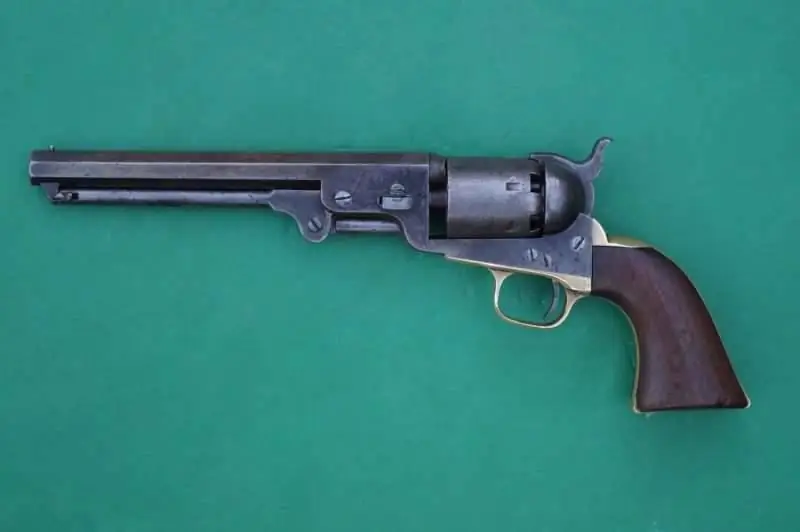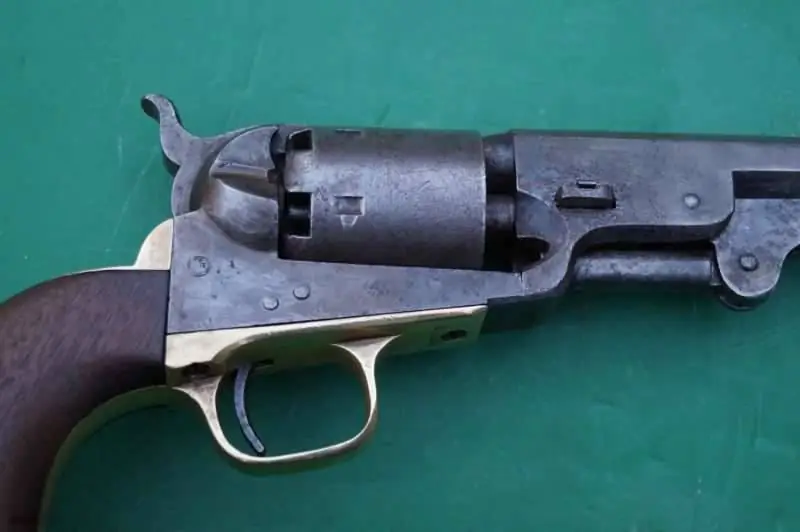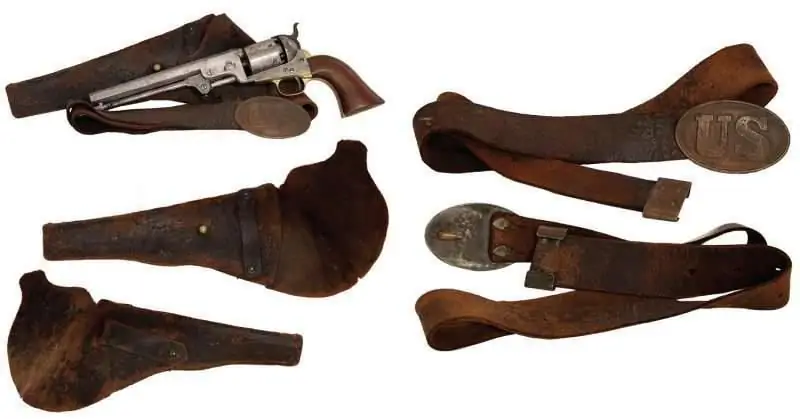- Author Matthew Elmers [email protected].
- Public 2023-12-16 21:49.
- Last modified 2025-01-24 09:17.

Revolvers Colt Walker and Colt Dragoons about which the website HistoryPistols.ru has already told are quite massive. Considering their size and weight, they were usually the weapon of the riders and carried in riding holsters. The Colt Baby Dragoon revolver is more compact, but its 0.31 caliber corresponds only to a self-defense weapon.
The need for a revolver that could be carried in a belt holster and was powerful enough prompted Colt to develop a new weapon.

The Colt 1851 Navy revolver designed by Samuel Colt between 1847 and 1850. Colt Navy 1851.36 caliber is much lighter than Walker or Dragoon and significantly more powerful than Baby Dragoon. The total length of the weapon is 330 mm, the barrel length is 190 mm, and the weight is 1190 grams. The revolver fits comfortably on a belt in a holster.

Samuel Colt originally called the weapon the New size Ranger revolver or simply Ranger. This is certainly no coincidence, as the new Colt was primarily intended for the Texas Rangers.

However, common people find an easier name for weapons. It is associated with the image of a naval battle on the surface of the drum. The revolver became known as the Colt Navy. The name was so entrenched in the weapon that from now on any revolvers made for 36 caliber were also called naval - Navy (for example: Remington Navy.36).

According to historians, the Colt 1851 Navy could have been produced as early as 1847, but the production facilities of the Colt company were loaded with numerous orders for the Colt Dragoons. For this reason, the serial production of the Colt Navy began only in 1851, in connection with which this figure appeared in the name of the weapon.

Colt received a patent on September 10, 1850, which noted the structural changes made to the design of the weapon. The design changes were associated, among other things, with an increase in the safety of handling weapons. Fundamentally, the design of the revolver has not changed. The Colt 1851 Navy is very similar to the Colt Dragoons.

The combustion products of black powder settled on the parts of the weapon, which required regular cleaning and lubrication of the revolver. Colt Navy 1851 is easy to disassemble, like its predecessors, which is very convenient for service.

The Colt Navy revolver of 1851 consists of a barrel, a frame, a drum, a firing mechanism, a drum turning mechanism, a chamber loading device and a handle. The handle of an ordinary revolver is made of walnut wood.

The barrel of the revolver is octagonal with a protrusion in the lower part for attaching the loading lever and fixing it in the frame. A front sight is installed in the upper part of the barrel at the muzzle.

In the stowed position, the hammer spoke closes the aiming line. After setting the trigger on a combat platoon, the slot in its upper part serves as a rear sight.

As a rule, the heads of all mounting screws are located on the left side of the revolver.

A lever is installed under the barrel for equipping the drum chamber. The front part of the lever in the stowed position is held by a special retainer installed in the lower part of the barrel at the muzzle.

The lever is hinged in the protrusion under the barrel of the weapon.

On the right side of the frame, a groove is made in the breech for equipping the drum's brand tubes with capsules. On the protrusion of the barrel on the right side, in front of the drum, there is also a recess for placing bullets in front of the lever for equipping the drum chamber.

Fixation of the barrel of the revolver in the frame is carried out using a special wedge that fits into the groove of the protrusion under the barrel on the left side of the weapon.

A correctly installed wedge presses the frame of the revolver through the axis of rotation of the drum to its barrel, rigidly fixing the parts of the weapon without gaps and backlashes.

The drum is cylindrical and has six chambers. The bridges between the brandtubes at the rear of the drum do not allow the hammer to hit the primer until the drum chamber is clearly against the barrel. This design significantly increases the shooter's safety.

Different engravings were applied to the drums of Colt revolvers, depending on the model. Here's an example of a promotional poster showing drum engraving options.

The drum of an 1851 Colt Navy revolver features a naval battle scene depicting the victory of the Republic of Texas Navy over the Mexican fleet at the Battle of Campeche on May 16, 1843.

This battle is famous for being, in fact, the only naval battle in which sailing ships opposed steam-powered ships.

Colt 1851 Navy revolver parts are marked with serial numbers and brands. Serial numbers are printed on the lower part of the grip and frame of the weapon, on the lower protrusion of the barrel, the front part of the trigger guard, the lower part of the drum shaft and on the surface of the drum after the text "COLTS PATENT No." On the upper edge of the barrel, there is a marking in the form of the text "ADDRESS COL. SAML COLT NEW - YORK U. S. AMERICA". On the left side of the frame under the drum, two lines of text “COLTS / PATENT” are visible. On the left, above the rear trigger guard, the caliber of the weapon is "36 CAL".

The revolver was equipped with a leather holster, which was attached to a waist belt. The cost of such a holster with a belt on the US antique market ranges from 400-800 dollars.

As a rule, a powder flask, a bullet and a set of primers were supplied with any Colt primer revolver.

Despite the relatively small size of the Colt 1851 Navy, it is still a heavy weapon. For the convenience of aimed shooting, attached butts were installed on some revolvers. To install the butt, special grooves were made on the sides of the breech of the frame, into which the upper part of the butt base was inserted.

An additional screw was installed in the frame to limit the movement of the butt base. After installing the butt, it was attached with a nut and a lower lock, which pressed the butt to the grip. Here is an example of a Colt Navy 1851 pistol with serial number 68220.

The Colt Navy revolver of 1851 became the second most popular Colt capsule revolver, second only to the Model 1849 Pocket Revolver. Colt's Patent Firearms Manufacturing Company in Hartford produced 215,348 Colt 1851 Navy pieces between 1850 and 1873. Approximately 42,000 more revolvers were made in Britain at the Colt's London Armory.

Colt Navy 1851 was made, of course, in a piece, gift execution.

The unique engraving of the frame and other parts of the weapon, the use of precious metals to cover the surface of the drum or other parts of the revolver, this is not a complete list of possible custom-made weapons.

Often, the cheeks of the handle of such weapons were made of bone and covered with skillful carving.

The average price at arms auctions for Colt 1851 Navy revolvers ranges from 2,000 to 4,000 dollars. However, for a rare weapon with a unique design, in the original weapon box, the price can reach several tens of thousands of dollars. At one of the American auctions, a revolver presented by Colt as a token of gratitude to Silas Cole is exhibited. S. Cole, a Canadian attorney, was hired by Colt as a patent attorney. The price for this revolver is $ 85,000.






